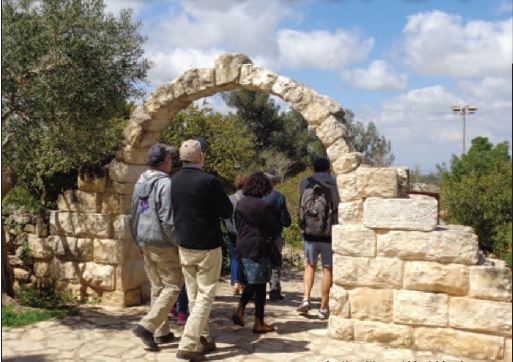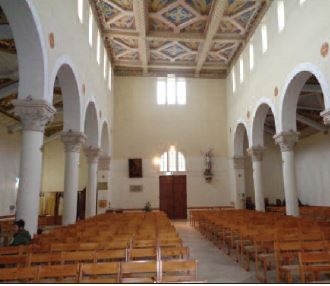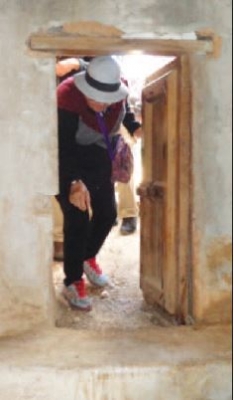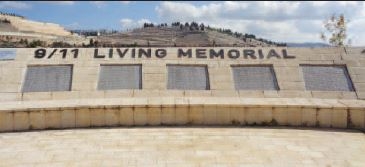The Jerusalem Corridor
After a very early start, due to our full program, the bus picked up the group from Raanana at 7am, and then picked up the group from Tel Aviv. From there we set off to the Elvis Café for refreshments and then headed to Latrun to pick up the last tour participants.
Unfortunately, the Benedictine Monastery had cancelled our visit at the last minute, but ESRA's Cecily Hanson, who organized the trip, had arranged for us to visit another church in Abu Ghosh, where our guide Beryl Ratzer had prepared a very interesting presentation. According to the Christian tradition, the Bible relates that King David carried the Ark of the Covenant from Kiryat Ye'arim to Jerusalem. One of the group members read out this interesting story inside the church, and we ended our visit in the lovely sunny courtyard of the church where we could see all of Abu Ghosh.
Next on the itinerary was a visit to Yad Hashmona. This community was founded in 1971 by a small group of Finnish Christians, and was named for eight Jewish refugees from Austria who escaped to Finland in 1938. The Finnish government, collaborating with the Nazis, handed the refugees over to the Gestapo in 1942. Seven of them died in Auschwitz and the only survivor, Dr. Georg Kolman, who lost all his family in extermination camps, later emigrated to Israel.
The community runs a guesthouse and convention center, and in 2000 a biblical village was inaugurated by the Swiss Beth Shalom Society and the Israel Antiquities Authority. We were guided throughout by a charming young American lady who is a member of the community. Our visit ended with a tour around the beautiful Biblical Garden, which has stunning views over the plains towards Tel Aviv.
After lunch, we headed off to the cemetery at Kibbutz Kiryat Anavim which was the first kibbutz established in the Judean Hills. It stands on thousands of dunams of land purchased in 1912 from the Abu Ghosh family by Arthur Ruppin, who represented the Zionist Movement.
During the War of Independence there were three Jewish settlements on the mountainous road to Jerusalem, Kiryat Anavim, Ma'aleh Hahamisha, and Neve Ilan. The three are close to the Arab village of Abu Gosh, whose inhabitants chose to take a neutral stand during the war. The majority of the fighting force gathered in this area and was called the Harel Brigade (Hativat Harel). The regimental headquarters were at Abu Gosh, and from here soldiers went out on their missions.
When they returned from their battles, the injured were brought to a field hospital, which was set up at the Abu Gosh church. The fallen were buried in the cemetery at Kibbutz Kiryat Anavim. After the war, many families chose to leave their loved ones in this cemetery, which became a symbol of the military battle for the road to Jerusalem. A monument was built next to the site of the military cemetery, in memory of the fighters. The sculptor Menahem Shemi, whose son Jimmy, was killed in the war, built the memorial. Both father and son are buried here. It is aptly named by some as the Warriors' Final Resting Place.
Our final stop was Givat Haradar, (Radar Hill), a memorial site for the Harel Brigade. This British installation was handed over to the Jordanian Arab Legion on May 10, 1948, prior to the second phase of the 1948 Arab-Israeli War, but it was finally captured in the Six Day War by the Harel Brigade. A monument for the fallen soldiers of the brigade stands at the top of the town.
We had a 'surprise' last stop. Our wonderful driver drove up through narrow roads and we had no idea where we were going – and then lo and behold – we arrived at the 9/11 Living Memorial Plaza located on a hill in the Arazim Valley of Ramot Jerusalem.
The plaza was built to remember and honor the victims of the September 9/11attacks. It is the only memorial outside the United States that lists all the names of the victims.
Following the 2018 Pittsburgh Synagogue shooting, the Jewish National Fund and JNF USA erected a stone plaque listing the name of the eleven victims of that attack, next to the 9/11 Living Memorial Plaza. In 2019 the Pittsburgh Mayor visited the synagogue memorial and planted an olive tree beside it "as a symbol of peace and continuity". A fitting inscription on which to end another wonderful ESRA outing.Enter your text here ...











Comments